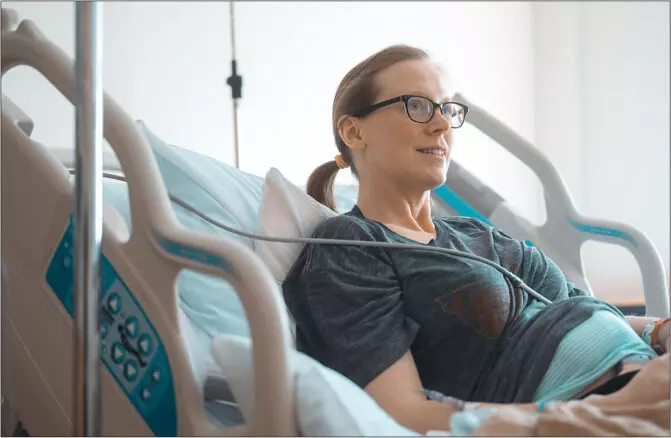
The FDA has granted accelerated approval to the combination therapy of avutometinib and defactinib (Avmapki Fakzynja Co-pack) for adults with KRAS-mutated, recurrent low-grade serous ovarian cancer who have previously undergone systemic therapy. This marks the first approved treatment specifically for this patient population, according to Verastem Oncology.
This indication is approved under accelerated approval based on the tumor response rate and duration of response. Continued approval for this indication may be contingent upon verification and description of clinical benefit in a confirmatory trial. AVMAPKI plus FAKZYNJA is only commercially available in the U.S. as an oral combination co-pack with the two prescription products, known as “AVMAPKI FAKZYNJA CO-PACK.”
“Today’s approval of AVMAPKI FAKZYNJA CO-PACK for patients with KRAS-mutated recurrent low-grade serous ovarian cancer represents not only the first-ever FDA-approved treatment specifically for this rare cancer but also a new day for people living with this disease who have been in desperate need of new treatment options,” said Dan Paterson, president and chief executive officer of Verastem Oncology. “We are very proud to bring two innovative medicines in one combination treatment to the LGSOC community. We thank the researchers, patients, and their families participating in our clinical trials, the patient advocacy community, the FDA, and everyone at Verastem for their dedication and commitment to helping us bring AVMAPKI FAKZYNJA CO-PACK to patients in the U.S.”
The accelerated approval of AVMAPKI FAKZYNJA CO-PACK is based on the Phase 2 RAMP 201 clinical trial, which evaluated the combination of AVMAPKI and FAKZYNJA in adult patients with measurable KRAS-mutated recurrent LGSOC.
“Low-grade serous ovarian cancer is a rare and highly recurrent cancer with limited effective treatment options. This first-ever FDA approval in this disease was based on the primary analysis of the Phase 2 RAMP 201 trial, in which the combination of avutometinib and defactinib resulted in a significant overall response rate for patients with a KRAS mutation while being generally well tolerated,” said Rachel Grisham, M.D., Section Head, Ovarian Cancer at Memorial Sloan Kettering Cancer Center in New York, NY and Global Lead Principal Investigator of GOG-3097/ENGOT-ov81/GTG-UK/RAMP 301. “The approval of avutometinib plus defactinib brings a much-needed therapeutic option to patients and establishes this combination as the new standard of care for women with recurrent low-grade serous ovarian cancer harboring a KRAS mutation. I look forward to progressing the confirmatory Phase 3 trial, RAMP 301, where we look to continue to support the ongoing body of research of this combination in women with and without a KRAS mutation.”
“To see our early research in both the FRAME and RAMP 201 trial in recurrent low-grade serous ovarian cancer advance the combination of avutometinib and defactinib to now be the first-ever FDA-approved therapy for this disease is what gives us real hope when treating patients with rare or difficult-to-treat gynecological cancers,” said Professor Susana Banerjee, M.B.B.S., M.A., Ph.D., F.R.C.P, Consultant Medical Oncologist at The Royal Marsden NHS Foundation Trust and Team Leader in Women’s Cancers at The Institute of Cancer Research, London and Global Lead Principal Investigator of ENGOTov60/GOG3052 /NCRI/RAMP201. “With this approval, we thank all of the patients and researchers who participated in this trial, and the low-grade serous ovarian cancer community for their contributions to help bring the first FDA-approved treatment for KRAS-mutated recurrent LSGOC and changing the treatment possibilities for RAS/MAPK-pathway-driven cancers. We now need to build on this milestone to bring this new treatment to patients around the world.”
Prior to this approval, there were no FDA-approved treatments specifically for KRAS-mutated recurrent LGSOC, a rare and distinct ovarian cancer that differs from high-grade serous ovarian cancer in both its biology and how it responds to treatment.
“One of the most devastating aspects of my LGSOC diagnosis was learning there are no FDA-approved treatments for this rare cancer. While there were some treatment options at the time that I could try, I made it my mission to advocate for research specific to my disease,” said Nicole Andrews, chair of the STAAR Low-Grade Serous Ovarian Cancer Foundation. “Today we’re celebrating a milestone with the first-ever FDA-approved treatment option specifically for patients with recurrent LGSOC with a KRAS mutation. The low-grade serous ovarian cancer community is hopeful and excited about the potential benefits of this treatment and the progress toward improving the diagnosis, awareness, and research for LGSOC.”
AVMAPKI FAKZYNJA CO-PACK is the first treatment to receive regulatory approval anywhere in the world, specifically for KRAS-mutated recurrent LGSOC. The Company believes AVMAPKI FAKZYNJA CO-PACK is also the first-ever oral, novel/novel combination therapy approved in oncology. Verastem initiated a rolling new drug application (NDA) with the FDA in May 2024 and completed its NDA submission in October 2024. The FDA granted Priority Review, and the approval was received in advance of its Prescription Drug User Fee Act (PDUFA) action date of June 30, 2025. The FDA granted Breakthrough Therapy Designation for the treatment of patients with recurrent LGSOC after one or more prior lines of therapy, including platinum-based chemotherapy, in May 2021. Avutometinib alone or in combination with defactinib was also granted Orphan Drug Designation by the FDA for the treatment of LGSOC.
The AVMAPKI FAKZYNJA CO-PACK is expected to be available for adult patients with KRAS-mutated recurrent LGSOC in the U.S. in one week.
About Low-Grade Serous Ovarian Cancer (LGSOC)
LGSOC is a rare ovarian cancer that is insidious and persistent. LGSOC is distinct and different from high-grade serous ovarian cancer (HGSOC) and requires different treatment. LGSOC is highly recurrent and less sensitive to chemotherapy compared to HGSOC. Approximately 6,000-8,000 women in the U.S. and 80,000 worldwide are living with this disease. LGSOC affects younger women with bimodal peaks of diagnosis at ages between 20-30 and 50-60 and has a median survival of approximately ten years. Approximately 70 percent of LGSOC shows RAS pathway-associated mutations, and 30 percent of people with LGSOC have a KRAS mutation. The majority of patients report a negative impact of LGSOC on their mental and physical health, fertility, and long-term quality of life. The current standard of care for LGSOC includes hormone therapy and chemotherapy.
About AVMAPKI and FAKZYNJA Combination Therapy
AVMAPKI (avutometinib) inhibits MEK kinase activity while also blocking the compensatory reactivation of MEK by upstream RAF. RAF and MEK proteins are regulators of the RAS/RAF/MEK/ERK (MAPK) pathway. Blocking RAF and/or MEK activates FAK, a key mediator of drug resistance. FAKZYNJA (defactinib) is a FAK inhibitor and together, the avutometinib and defactinib combination was designed to provide a more complete blockade of the signaling that drives the growth and drug resistance of RAS/MAPK pathway-dependent tumors.
Additional clinical investigations: Verastem Oncology is conducting clinical trials with avutometinib with and without defactinib in RAS/MAPK-driven tumors as part of its Raf And Mek Program or RAMP. RAMP 301 (GOG-3097/ENGOT-ov81/GTG-UK) (NCT06072781), is an international Phase 3 confirmatory trial evaluating the combination of avutometinib and defactinib versus standard chemotherapy or hormonal therapy for the treatment of recurrent low-grade serous ovarian cancer (LGSOC) with and without a KRAS mutation.
RAMP 203 (NCT05074810) is a Phase 1/2, multicenter, open-label, dose evaluation/expansion study, being conducted in collaboration with Amgen, evaluating the efficacy and safety of avutometinib and sotorasib with or without defactinib in patients with KRAS G12C mutant non-small cell lung cancer (NSCLC) who have not been previously treated with a KRAS G12C inhibitor as well as in patients who have been previously treated with a KRAS G12C inhibitor (NCT05074810). RAMP 205 (NCT05669482), a Phase 1b/2 clinical trial evaluating avutometinib and defactinib with gemcitabine/nab-paclitaxel in patients with front-line metastatic pancreatic cancer, is supported by the PanCAN Therapeutic Accelerator Award. Avutometinib and defactinib are not approved by the FDA or any other regulatory authority, either in combination or with other therapies, for any of these investigative uses. Neither avutometinib nor defactinib are approved by the FDA or any other regulatory authority on a stand-alone basis for any use.






